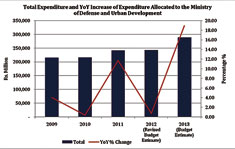Allocations for education, healthcare see no growth

The country is pushing ahead for ‘jobless growth’ with allocations to Defence in the 2013 budget growing significantly, and although the Urban Development Authority (UDA) functions under the Ministry of Defence, its share of the allocation is less than 5 percent, while education and healthcare do not see much improvement in allocations.
“The 2012 budget had allocated 1.31% of GDP for the health sector. The 2013 budget allocates about the same: 1.33%. However, the actual disbursement in 2012 was cut down to 1.26%. The direct expenditure on education, represented by the allocations made to the Ministry of Education, Higher Education and to the Provincial councils on education amounted to only 131 billion accounting for 1.51% of GDP (5.21% of government expenditure). A clear downward trend is evident in the allocations made to the education sector as a percentage of GDP in four successive budgets from 1.81% in 2010 to 1.51% in 2013. This is driven by sharp decreases in current expenditure on education,” a think tank showed.
Verite Research Pvt. Ltd in a recent a report ‘Sri Lanka Budget 2013: Increasing Assistance and Vulnerability’, said: “Sri Lanka’s huge defence budget which refused to shrink post war has continued to grow, and at almost 19% in Budget 2013. Capital expenditure has been growing faster than recurrent expenditure in the post-war period, and in Budget 2013.
“The joining in of the Urban Development function has sometimes been conjectured as an explanation for the growth of this budget. To assess, Verité Research has analysed the detailed budget and separated defence and Urban Development related allocations. The Urban Development related allocations accounted for less than 5% of the Ministry’s budgetary allocations.
“The wages and upkeep of security forces and staff account for at least half of this budget, with no plans announced to re-skill and encourage the carders towards integrating into the productive economy,” Verite Research (VR), a think tank that provides strategic and policy advice to both the state and private sector in the areas of economics, politics, law and media, said.
“Re-integration would be a challenge in any case, as the economy is displaying the phenomenon of “Jobless Growth”. The number of jobs in seven provinces outside of North and East remained the same in mid-2012 as it was in 2006; despite growth in real GDP being recorded at over 40% in the same period.”
According to VR, this ministry receives one of the highest budget allocations, despite the large expenditures relating to offensive military operations ending in May 2009. The allocation of Rs 289,502,534 million in 2013 is an increase of Rs 46 billion and 18.9% over 2012. This is so far the highest annual increase in this budget in the post war period. The increase consisted of recurrent and capital expenditure increasing by Rs 29 billion and Rs 17 billion respectively.
“Air Force Increases in Priority: State security accounts for 73.3% of the Ministry’s total allocations, with the biggest share going to the Sri Lankan army (42.2%). That share has fallen overtime from 52.5% in 2009 to 42.2% in 2013. The share allocated to the Sri Lanka Air force shows a significant increase from 9.25% to 14.34% during the reference period. This reflects a 68% growth in the Sri Lanka Air Force budget driven largely by increases to the capital expenditure component.
“Employment as indirect welfare: 147 billion or 51% of the Defence and Urban Development Budget is spent on wages and other benefits to those employed. Comparing the claim in the budget speech that the government employed 1.3 million, against the official count of the public sector by the department of census and statistics at around 1 million, it can be deduced that the numbers in the military are around 300,000. There are indications that military personnel have been increasingly used in non-military activities, including in small scale business enterprises, and assistance to other areas of the public sector. However, this has meant that soldiers are often engaged in activities that are not related to their skill sets, and are also not being formally re-skilled in preparation for productive engagement in the economy. The 2013 budget does not indicate any move to change this status quo. These employments and benefit payments can therefore be considered as an indirect welfare scheme. The main deterrent to re-skilling and de-mobilisation of the forces is that the Sri Lankan economy despite recording high levels of growth has not been creating jobs.
“The problem in a nutshell is as follows: Excluding the Northern and Eastern Provinces the labour force and employment statistics data for Sri Lanka recorded the existence of 7,105,322 jobs (number employed) in the country, in 2006. Since then, despite the real GDP growing in excess of 40%, job growth was less than 1%. (The number of jobs recorded in the second quarter of 2012 was 7,120,518). Increased Discretion: However, while this welfare-through-unproductive employment dimension explains a significant portion of the budget, it does not account for the increases in the budget. While the 2013 budget is an increase of 18.9% over 2012, the wages and benefits component increases by only 7%. The large, non-wage, expenditures increases cannot be traced back to a set of proposals presented to parliament. There is little evidence then of parliament actively exercising its constitutional role of financial oversight with regard to the expenditure priorities of the defence budget. The lack of such oversight provides increased discretion on the priorities and quantities of expenditure to the Minister, who in this case is also the President,” Verite Research pointed out.
“Within the budget, priority towards urban development has also increased with an annual increase of 86.3% in that section of the budget. Nevertheless, as a whole, urban development accounts for only a small part of the budget of this Ministry. Of the 289 billion budgeted, the amount allocated for urban development is just 13.8 billion, which is 4.7%.”
IS